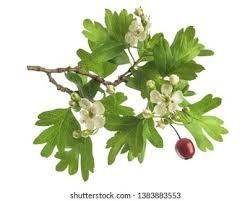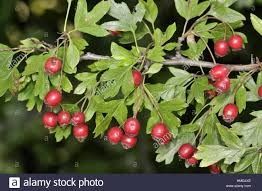How to Identify the Mature English Hawthorn tree
Learn how to see the smaller, uniquely-shaped leaves, the spotted silvery trunks, and the long, sharp, dark thorns. An important video to see, since the English Hawthorn (Crataegus monogyna) is the easiest hawthorn to find in a forested area. Happy hunting!
How to Dry and Steep Hawthorn Leaves to Make the Tea
Drying and steeping procedures are shown. Steeping time is 14 minutes. Berries are also discussed. August 15 is the Feast of the Assumption, and we are to offer these leaves to the Blessed Virgin Mary on the Monday after her feast day and ask her to bless them. This tea is mild tasting and is meant to help us with respiratory congestion. May Christ our Lord bless you all.
Gathering Hawthorn leaves in Spring
Grandmother English Hawthorn Is a Must-See!
This tree probably was the first planted in this area. English Hawthorn is originally a European native.
Hawthorn in May time
Look for these distinctive flowers in the trees in your neighbourhood woods and hedges and you will have found the best medicinal hawthorn tree!
How to Identify English Hawthorn trees, Part 1, the Baby Tree
This is the first of 2 videos on looking at baby English Hawthorn trees (Crataegus monogyna). Look at the commonalities, such as the leaf shape. Look at the differences with the growth of the thorns. Interesting! The opening photo shows berries that are not yet ripe. They should be red before you pick them for the seeds.
How to Identify English Hawthorn trees, Part 2, the Baby Tree
These little scrappers should be called spear trees! In this very short video, we discover how the side thorns shoot out to become the branches for the tree! Just wondrous! Remember, where the baby trees are, the mama and papa trees will be in the vicinity. The Latin name of English Hawthorn is Cragaegus monogyna.
On the Monday after August 15, (the Feast of the Assumption)!
Now is the time to collect the hawthorn leaves and offer them to our Blessed Mother on the Monday after August 15, so that they will heal us from the disease with a burning fire; see prophecy at the end of this post.
Hawthorn grows as a tree or as a bush. Craetagus monogyna (English hawthorn) is the leaf we want for the medicinal tea, but be careful, because there are many other hawthorne trees that you can find throughout North America and the world, and the leaves are usually tooth-like (think of a saw for cutting wood).
The key thing to look for is thorns growing out of branches.
IMPORTANT: If you are purchasing this medicinal hawthorn tree, remember that it is a deciduous tree, which means it will lose its leaves in the autumn. Remember, evergreen leaves tend to be poisonous (ex: rhododendrons).
Please read the prophecy about this:
A Disease with a Blazing Fire
“Grave diseases will arrive, which human craftsmanship will be unable to relieve. Which disease will attack first the heart, then the mind, and at the same time the tongue. That will turn out horrible. The heat accompanying the disease will be a devouring fire, intolerable and so violent that the parts of the body touched with it will be red from an intolerable redness. At the end of seven days, that disease, scattered around like seed in a field, will rapidly grow on every side, realizing immense progressions.
“My children, here is the only remedy with the power of saving you. You know the leaves of the thorns which are growing in almost all the hedges. The leaves of those thorns may arrest the progression of that disease.
“You will pick up the leaves, not the branch. Even dried up, they will retain their efficacy. You place them in boiling water, leaving them for fourteen minutes, keeping the container covered, so that the steam remain inside. From the very start of the attack by the disease, that remedy will have to be used three times a day.
“On the Monday after my Assumption, you will offer those leaves of the thorn-bush to me, and you will pay attentive heed to my words.
“My children, that disease will be strong in Brittany. The thought of God will be much lesser around there . . . the disease will produce a continuous sickness on the stomach, vomiting. If the remedy is taken in too late, the touched parts of the body will turn out black, and through the black part there will be traces turning to pale yellow. (August 5, 1880).”
[Source: p. 270, Prophecies of La Fraudais].
CRUCIAL: Not All Hawthorns are the Right Medicinal Hawthorn
Quick Recognition: Smooth shiny sharp thorns (usually under leaves); showy 5-petaled flowers in flat-topped clusters; broad rounded terminal buds; small apple-like fruits, often persisting in winter.
Habitat: Occuring on abandoned farmland, along streams, and in forest openings, especially on soils high in calcium. Moderately shade tolerant. Often forming thickets of several different species [kinds of hawthorn = the different names, such as Black hawthorn].
Size and Form: Shrubs to small trees up to 12m (39ft) high and 30 cm (1 ft) in diameter. Often with a distinct, crooked trunk; sometimes multistemmed and shrubby. Crown low, wide-spreading, somewhat rounded or flat topped.
Common Names: English Hawthorn, European Hawthorn, or One-seeded hawthorn
Botanical Name: Crataegus monogyna
Very small trees up to 8m (26ft) tall, introduced from Europe; naturalized in Canada; frequently planted as ornamentals.
Hardy as far north as Zones CA3, NA4.
Leaves 2 - 3cm (1in) long, 3 - 7 deep lobes; cut nearly to the midvein; lobes narrow, obscurely toothed; veins running to the notches as well as to the lobes.
Thorns short, 1 - 2cm (1/2 - 3/4in) long, gray, straight.
Flowers rose-colored; dark red, bright red, pink, or white.
Fruits scarlet to deep red, glossy, 6 - 8mm (up to 1/3in) across, with 1 seed.

